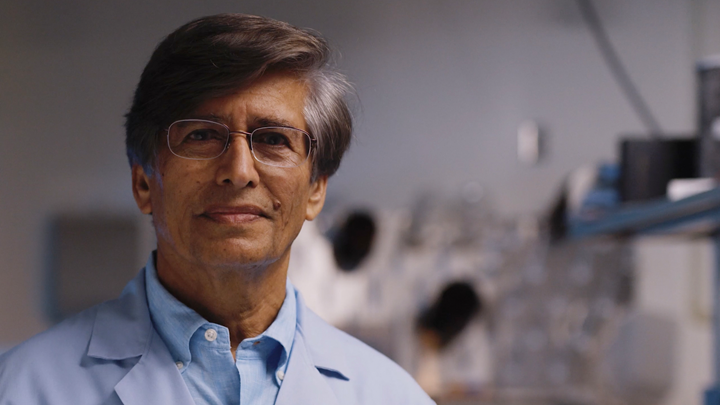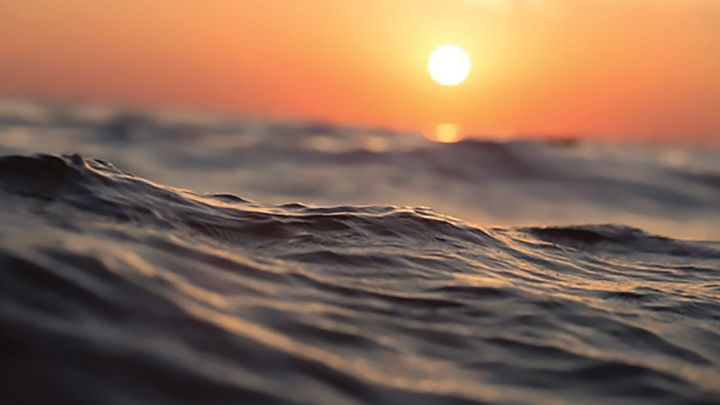Current Features
Research: Faculty Develop Solutions to Pressing Issues

Molekule makes an impact
By Tina Meketa | USF News
THE COMMERCIAL SUCCESS OF TECHNOLOGY created at USF is having a ripple effect on the state of Florida’s economy. Yogi Goswami, distinguished university professor and inventor of the Molekule air purifying system, is responsible for the creation of 47 jobs with an average salary of $70,000, generating valuable tax revenue for the state.
The Molekule is manufactured in Lakeland, where dozens of employees help assemble parts for the five-line company – Air Mini, Air Mini+, Air, Air Pro and Air Pro RX. Patented at USF, the technology uses photo electrochemical oxidation to capture and destroy airborne bacteria and viruses, such as COVID-19. Several of the lines have received FDA 501(k) clearance as Class II medical devices, meaning they’re safe to use in operating rooms, emergency department waiting rooms and isolation units.
“We started this business to help people. I invented the technology and developed the product for our son, who suffered from debilitating asthma and allergies, and then others known to us who had similar problems, so we started scaling up to help other people,” Goswami says. “Certainly, as a private company, we like to make a profit so we can keep people employed, but at the same time, the core philosophy is that we are here to help people with our technology.”
Goswami conducted rigorous research for 20 years before he, his wife, Lovely, and children Dilip and Jaya formally founded Molekule in 2016. Today, eight doctoral and post-doctoral students conduct research and product development for Molekule at the USF Research Park. Several USF graduates are now full-time researchers with the family-owned business, including Goswami’s former student, Phil Myers, who’s been with Molekule for five years. Myers earned his master’s and doctoral degrees in chemical engineering at USF and is now the senior principal research engineer at Molekule, where he works on the Research and Development team, designing and implementing testing strategies for future products and technologies.
“Molekule has had a significant impact, helping lead a wave of new commercial and industrial development in the region,” Myers says. “It’s been exciting to see the business’s manufacturing facility expand over the years and to be able to take advantage of the great talent produced at USF.”
Molekule projects to more than double its production by the end of 2022 – enhancing its economic impact on the region and state. The product line has grown in popularity throughout the COVID-19 pandemic and Molekule has paid it forward, donating thousands of units to hospitals and schools across the globe. The company has also contributed $500,000 for research at the Clean Energy Research Center at USF, for which the Florida High Tech Corridor has provided matching funds, accounting for a $1 million investment in USF research. This has helped fund undergraduate, graduate and postdoctoral fellowship research, bringing Goswami’s and Molekule’s success full circle.

The USF College of Marine Science: an anchor of research and innovation in shifting seas
By Kristen Kusek MA, MS ’98 | USF College of Marine Science
FLORIDA MAN’S GOT NOTHING ON THE HEADLINES about coastal and climate change in Florida.
Red tides fueled by land-based nutrients can make people sick, devastate sportfish populations, and flatten economies and livelihoods. A recent report by the University of Florida documented a hit of $184 million to the southwest Florida economy from the 2018 red tide.
High-tide flooding events on sunny, blue-sky days silently nibble away at your chassis. These “king tides” or “sunny day flooding” events are projected to rise significantly in the next 10 years. The flooding risks increase when combined with extreme rainfall events.
Flood insurance costs skyrocket because of hurricanes such as Ida that mushroom from a Category 1 to a Category 4 within a handful of hours. Ida made landfall in Louisiana and stayed fierce enough to flood subways and basements in New York City and New Jersey — even after a 1,400-mile journey over energy-sapping land.
We are watching scientific predictions unfold like a live action movie in the Sunshine State and adjacent waters in the Gulf of Mexico and Atlantic Ocean.
But there is good news, and reason to take a deep breath.
“Innovation is critical as Florida and communities around the globe grapple with this suite of natural hazards and new normals,” says Tom Frazer, dean of the USF College of Marine Science. “Our college is now front and center in this innovation space, and we look forward to ensuring the action-based research we produce will benefit Florida communities statewide.”
The college was recently designated as the home for a new state-funded Flood Hub for Applied Research & Innovation.
In a recent opinion piece in the Tampa Bay Times, J.P. Booker, director of Florida Conservation for the Ocean Conservancy, wrote, “The creation of the Flood Hub is a laudable achievement and will provide a quintessentially important clearinghouse of information and data on the impacts that the rising sea will have on our state — the modeling that will be produced by the Flood Hub will be invaluable for forecasting floods, floodplain inundation mapping, and assessing economic damage.”
And this: “With the former Chief Science Officer of Florida Tom Frazer at the helm at the College of Marine Science, the Flood Hub is certain to be a resilience science powerhouse.”
The college will not do the work alone.
“Our power lies in our partnerships,” Frazer says.
While the college holds broad expertise in coastal resiliency, long-term sea level rise, paleoclimate change, ocean acidification, harmful algal blooms, fisheries management, oil spill response and recovery, water quality, and shoreline change, it is also the backbone to a bevy of marine science expertise in St. Petersburg that includes:
- USGS St. Petersburg Coastal and Marine Science Center
- NOAA National Marine Fisheries Service
- Florida Fish and Wildlife Research Institute
- Florida Institute of Oceanography
- Tampa Bay Estuary Program
- US Coast Guard
- St. Petersburg Innovation District
According to statistics tracked by the St. Petersburg Innovation District, the marine science community within St. Petersburg contributes $251 million in gross county product. More than 1,900 people within the district hold marine science-related jobs.
The college’s partnership list is long, built and nurtured over nearly 55 years.
The college also works closely with colleagues across USF’s 13 colleges; holds strong partners at the state level as part of the Florida Climate Institute and various regional climate coalitions, such as the Southeast Florida Climate Compact and the Tampa Bay Regional Resiliency Coalition; and with key industry groups, such as the Urban Land Institute that enable its research teams to serve as a bridge between the scientific community, the public at large and key public policymakers.
More good news:
The college recently announced it has joined the Ocean Visions Research Consortium, which includes a healthy list of ocean science powerhouses such as Scripps Institution of Oceanography, MIT, and the Woods Hole Oceanographic Institution.
The mission of the Ocean Visions Network, established in 2019, is two-fold: To address the disconnect between research and ocean solutions, and to mobilize research universities and institutions, professional ocean-focused societies, NGOs, IGOs, foundations, business and financial institutions, into action. Its stated vision is easy to support: “A world where smart design and equitable solutions foster a thriving ocean for all that depend on it.”
A key focus for Ocean Visions is coastal resiliency and reversing the climate crisis in the ocean, Frazer says.
“Not only do these partnerships ensure that the actionable science results we generate are robust but that they can be applied in a timely manner at regional and national levels and also find their way into the hands of decision-makers and citizens,” says Gary Mitchum, associate dean and professor of physical oceanography in the college.
Last but certainly not least: in 2020, the college was awarded a five-year, $9 million cooperative agreement by the National Oceanic and Atmospheric Administration’s (NOAA) Office of Coast Survey to launch the Center for Ocean Mapping and Innovative Technologies (COMIT). The center will develop new technologies and approaches to ocean and coastal zone mapping in line with NOAA’s commitment to building resilient coastal ecosystems, communities and economies.
A surprisingly small percentage of the ocean floor has been adequately mapped, including that around the state of Florida.
“This partnership will enable us to deliver detailed maps of the seafloor that will help improve our ocean prediction and modeling efforts for the Florida coast so they include more precise storm surge and inundation forecasts,” says Steve Murawski, the College of Marine Science professor who led the 10-year research effort in response to the Deepwater Horizon oil spill, and now leads COMIT.
One of its first field missions, slated for the end of this year, will harness the power of cutting-edge aerial and autonomous ocean-based technologies to develop high-resolution maps of parts of the seafloor in Tampa Bay and the Gulf of Mexico that feed into prediction models. The target areas comprise a complex set of challenges to conventional mapping technologies because of depth, water clarity, ship/boat traffic and habitat types that make it a solid model for mapping around the state of Florida, Murawski says.
“All of these initiatives are tied by a singular mission: To help us responsibly manage the rich array of precious natural resources found in our backyards that are so vulnerable to human activities and natural disasters,” Frazer says.
Florida’s coastal economy
- Coastal tourism and recreation contribute over 1.7 million jobs to the nation’s economy
and over 200,000 jobs and $50 billion to the state’s economy.
- The fishing industry contributes more than the cattle and citrus industries combined.
Seafood sales contribute more than $30 billion to the state’s economy.
- Florida is uniquely dependent on maritime transportation for supply of petroleum products and other commodities for its growing economy. The Gulf of Mexico supplies more than 90 percent of offshore oil and gas to the nation and 40 percent of the seafood supply caught off the continental U.S.